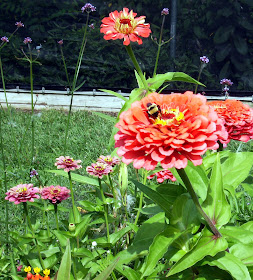Most of my gardening is Perennial plants, I but I do enjoy the the annuals for that pop of color. Annuals are also are good if you live in a apt. or condo and have no yard. Below are some pictures of some of my annuals and some tips and ideas for sun or shade plants.
Plants that good for a shady area..
 |
| Impatiens |
Impatiens are a mainstay in medium shade to all but the heaviest shade, look fabulous in mass plantings, are so easy to propagate that it's almost ridiculous, and don't require much care other than appreciating halfway decent quality, well drained but moist soil and adequate watering. Impatiens also make excellent container plants, and cascade beautifully over the sides of a container for a lush look that requires minimal effort on the part of the gardener. They love Miracle grow.
 |
| Impatiens |
|
|
Nicotiana, Flowering Tobacco
 |
| Nicotiana |
Nicotiana is easy to grow. Flowers begin to appear and bloom in the early summer. The plant will rebloom all season. Flowers open up in late afternoon, and are on fragrant display all evening.
Did you Know? It should come to no surprise that Nicotiana is also called Tobacco Flower, or Flowering Tobacco. And.....yes, Nicotiana has high concentrations of nicotine.
Nicotiana looks good in mass plantings as bedding plants, or in clumps. You will want them to grow in groups, to enjoy their fragrance. They are best placed towards the middle of the flower garden. Try some on or near your patio or deck. Make sure to locate some under a window of your house. When the plants are in bloom, their fragrance can waft in through an open window. They can be grown in pots and containers, too.
Plants flower and bloom best in partial shade .
Coral Bells
 |
| Coral Bells |
Coral bells, are some of my favorite container garden plants for shade. They are gorgeous and almost indestructible and come in a huge array of colors. Thriving in the shade, most coral bells will also tolerate some sun and are drought tolerant.
Coral bells come in fabulous and unusual colors, ranging from an almost black-purple to a peach to a bright key lime. Coral bells will attract hummingbirds, and butterflies and some are hardy to a spectacular.
Plants that love the sun
Vinca or Periwinkle
Vinca or Periwinkle is a prolific heat and drought tolerant annual, perfect for hot, dry areas. It's easy to grow, and requires little or no attention.
The plants are grown for its attractive glossy, green foliage, as well as its flowers. Flowers bloom all summer, and up to frost.
Vinca or Periwinkle will grow in range of light conditions, from full sun to shade
 |
| Vinca |
Geraniums
Geraniums are one of the most reliable plants in the home garden.
Planting in late May is preferable for the most productive plants. Plant geraniums where they will receive sunlight for best flower production. Select a site where water drainage is good.
Geraniums will grow in almost any type of soil if well-aerated and porous. I like to add to the soil Perlite & Vermiculite
because of the physical shape of each particle, air passages are formed which provide optimum aeration and drainage.
 |
| Geranium |
Water geraniums at least once a week if you have had no rain.
Geraniums dislike having wet leaves and flowers so it is best to use a soaker hose but if that isn't possible, water early in the day to allow leaves and flowers to dry before nightfall.
Tip: To promote continuous blooming, pinch or cut off the blooms after they die.
Million Bells
 |
| Million bells |
This plant comes in about a million spectacular colors that range from pure white to different shades of pink to deep purple. Million Bells look great in almost any container garden. The prolific blossoms attract hummingbirds and butterflies and will go strong all summer with regular feeding, don't need deadheading but do need consistent watering and good drainage - no soggy roots for these guys.















































